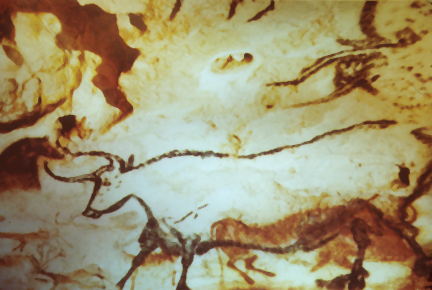
'HALL OF BULLS,' Cave Painting from Lascaux, France
28,000 - 10,000 BCE
ART 198 - HISTORY OF WORLD CERAMICS
| Dated between 28,000 and 10,000 BCE, the beautiful paintings on cave walls found near Lascaux, France represent the earliest surviving examples of the artistic expression of early people. Using the natural rock contours that suggest the volume of the animals, these 'primitive' people of the Paleolithic (Old Stone Age) painted evocative and startlingly accurate representations of the animals that were such an important part of their lives. Cows, bulls, horses, bison, and deer are among the animals seen on the subterranean walls of these caves. These paintings were found deep underground, and were undoubtedly painted by the light of torches. Moreover, images are painted over previous images, and it is thought that these caves were continuously used for thousands of years. Caves symbolized the birth canal, with life emanating from within. These animals were of utmost importance to the survival of the people of this time, and their continued creation was essential. Through sympathetic magic, perhaps these early humans believed that by drawing these images, they would help to guarantee plentiful herds and good hunting. Another theory is that it was believed that man had to paint these images to 'replace' the animals that he would hunt and kill. Whatever the motivation, it is clear that the painting of these images was important, and the careful observation of nature that is evident here is remarkable. These early artists painted with charcoal from their fires, and used earth pigments of iron and manganese to create the permanent colors we still see today. These, of course, are the very same pigments used in ceramics, and the discovery of these minerals during the Paleolithic was an essential stepping stone for the development of polychrome slip painting during the Neolithic to follow. | 'HALL OF BULLS,' Cave Painting from Lascaux, France 28,000 - 10,000 BCE |
|
|